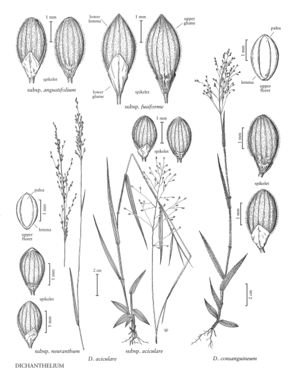familyPoaceae
subfamilyPoaceae subfam. Panicoideae
genusDichanthelium
speciesDichanthelium aciculare
subspeciesDichanthelium aciculare subsp. fusiforme
Difference between revisions of "Dichanthelium aciculare subsp. fusiforme"
Synonyms: Panicum fusiforme
Treatment appears in FNA Volume 25. Treatment on page 444.
FNA>Volume Importer |
imported>Volume Importer |
||
| (5 intermediate revisions by 2 users not shown) | |||
| Line 6: | Line 6: | ||
|synonyms={{Treatment/ID/Synonym | |synonyms={{Treatment/ID/Synonym | ||
|name=Panicum fusiforme | |name=Panicum fusiforme | ||
| − | |authority= | + | |authority= |
| + | |rank=species | ||
}} | }} | ||
|hierarchy=Poaceae;Poaceae subfam. Panicoideae;Poaceae tribe Paniceae;Dichanthelium;Dichanthelium sect. Angustifolia;Dichanthelium aciculare;Dichanthelium aciculare subsp. fusiforme | |hierarchy=Poaceae;Poaceae subfam. Panicoideae;Poaceae tribe Paniceae;Dichanthelium;Dichanthelium sect. Angustifolia;Dichanthelium aciculare;Dichanthelium aciculare subsp. fusiforme | ||
| Line 15: | Line 16: | ||
}}<!-- | }}<!-- | ||
| − | --><span class="statement" id="st-undefined" data-properties=""><b>Resembles </b>< | + | --><span class="statement" id="st-undefined" data-properties=""><b>Resembles </b><i></i>subsp.<i> angustifolium</i> vegetatively except that the culms are often taller and more slender. <b>Panicle</b> branches ascending, not appearing 1-sided. <b>Spikelets</b> 2.9-3.6 mm, fusiform, bases strongly attenuate, apices pointed or beaked, lower glumes attached 0.3-0.5 mm below the upper glumes.</span><!-- |
-->{{Treatment/Body | -->{{Treatment/Body | ||
| Line 27: | Line 28: | ||
-->{{#Taxon: | -->{{#Taxon: | ||
name=Dichanthelium aciculare subsp. fusiforme | name=Dichanthelium aciculare subsp. fusiforme | ||
| − | |||
|authority=(Hitchc.) Freckmann & Lelong | |authority=(Hitchc.) Freckmann & Lelong | ||
|rank=subspecies | |rank=subspecies | ||
| Line 34: | Line 34: | ||
|basionyms= | |basionyms= | ||
|family=Poaceae | |family=Poaceae | ||
| + | |illustrator=Linda A. Vorobik;Hana Pazdírková | ||
| + | |illustration copyright=Utah State University | ||
|reference=None | |reference=None | ||
|publication title= | |publication title= | ||
|publication year= | |publication year= | ||
|special status= | |special status= | ||
| − | |source xml=https:// | + | |source xml=https://bitbucket.org/aafc-mbb/fna-data-curation/src/200273ad09963decb8fc72550212de541d86569d/coarse_grained_fna_xml/V25/V25_1207.xml |
|subfamily=Poaceae subfam. Panicoideae | |subfamily=Poaceae subfam. Panicoideae | ||
|tribe=Poaceae tribe Paniceae | |tribe=Poaceae tribe Paniceae | ||
Latest revision as of 18:56, 11 May 2021
Resembles subsp. angustifolium vegetatively except that the culms are often taller and more slender. Panicle branches ascending, not appearing 1-sided. Spikelets 2.9-3.6 mm, fusiform, bases strongly attenuate, apices pointed or beaked, lower glumes attached 0.3-0.5 mm below the upper glumes.
Discussion
Dichanthelium aciculare subsp. fusiforme grows in sandy pine or oak savannahs. It tends to replace D. aciculare subsp. angustifolium from southern Florida through Central America and the Antilles.
Selected References
None.
Lower Taxa
None.
... more about "Dichanthelium aciculare subsp. fusiforme"
